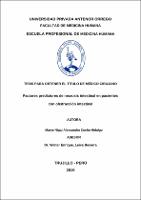Factores predictores de necrosis intestinal en pacientes con obstrucción intestinal

View/
Download
(application/pdf: 308.7Kb)
(application/pdf: 308.7Kb)
Date
2019Author(s)
Cucho Hidalgo, Marye Nigaj Alessandra
Metadata
Show full item recordAbstract
Introducción: La necrosis intestinal es una de las complicaciones más desfavorables de la obstrucción intestinal, su identificación oportuna puede mejorar la sobrevida del paciente afectado. Objetivo: analizar cuáles son los factores predictores de necrosis intestinal en pacientes con obstrucción intestinal. Método: Estudio transversal analítico en donde se revisaron 168 historias clínicas (90 pacientes con necrosis y 78 sin necrosis) de pacientes con obstrucción intestinal atendidos en el departamento de cirugía general del Hospital Regional Docente de Trujillo entre el 2015 y 2018. Se calculó el Odds Ratio (OR) para el análisis bivariado y se realizó el análisis multivariado mediante regresión logística para establecer los factores predictores de forma independiente. Resultados: La fiebre, ascitis, leucocitosis, razón neutrófilo/linfocito y espesor intestinal, mostraron asociación en el análisis bivariado (p<0.05). Luego de ajustar a las variables de confusión, solo la ascitis (ORa 6.12), razón neutrófilo/linfocito mayor a 8 (ORa: 7.23) y el aumento del espesor intestinal (ORa: 10.79), se mantuvieron como factores asociados de forma independiente. Conclusión: La ascitis, la razón neutrófilo/linfocito mayor a 8 y el aumento del espesor intestinal son los factores predictores de necrosis intestinal en pacientes con obstrucción intestinal. Introduction: Intestinal necrosis is one of the most unfavorable complications of intestinal obstruction, its timely identification can improve the survival of the affected patient. Objective: to analyze the predictive factors of intestinal necrosis in patients with intestinal obstruction. Method: Cross sectional study where 168 medical records (90 with necrosis and 78 without necrosis) of patients with intestinal obstruction treated in the department of general surgery of the Teaching Regional Hospital of Trujillo between 2015 and 2018 were reviewed. The Odds Ratio was calculated (OR) for the bivariate analysis and the multivariate analysis was performed by logistic regression to establish the predictive factors independently. Results: Fever, ascites, leukocytosis, neutrophil/lymphocyte ratio and intestinal thickness showed association in the bivariate analysis (p <0.05). After adjusting for the confounding variables, only ascites (ORa 6.12), neutrophil/lymphocyte ratio greater than 8 (ORa: 7.23) and intestinal thickness increase (ORa: 10.79) were maintained as independent factors. Conclusion: Ascites, neutrophil/lymphocyte ratio greater than 8 and increased intestinal thickness are the predictive factors of intestinal necrosis in patients with intestinal obstruction.
Collections
- Medicina Humana [2969]

